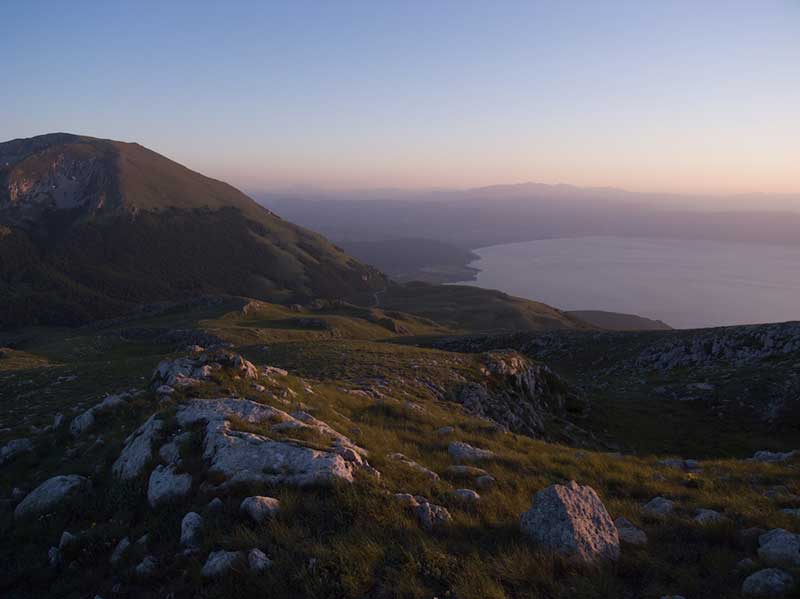Macedonia is characterized with various natural beauties: high mountain massifs rich in flora and fauna, mountain rivers and tectonic lakes, numerous thermal springs, basins, and valleys.
Among the thirty-four mountain peaks higher than 2.000 meters above sea level, the highest one, is Great Korab with an altitude of 2.753 m. The mountainsides are frequently covered with snow throughout the year, so that some of them are perfectly attractive and suitable for winter sports. Deciduous and evergreen trees, spacious pastures, meadows and other vegetation, can be found on the mountains.
Various kinds of game, in particular bears, boars, deer and mouflons, provoke the development of hunting. The most gleaming mountainous eyes are the lakes situated picturesquely in the tourist-appealing mountains Sara and Pelister.
The highest, best known and, exquisitely beautiful, is the mountain Sara. Due to its rich vegetation and wildlife on the one hand, as well as because of the preserved and unpolluted environment, it represents a real mecca for tourist resorts and sports facilities, where medical herbs can be picked up, or game hunts can be arranged, Nowadays, it is renowned in Europe for its tourist and sport facilities.
The mountain Sara is also rich in spacious pastures, which provide excellent opportunities for animal husbandry. High quality dairy products, mainly cheese and feta cheese, are made in the many sheepfolds on Sara and the adjacent mountains. The best known kinds of feta cheese are Sara and Galicnik.
The various kinds of game that exist on Sara attract quite a few tourists, particularly those who are passionately inclined to hunting. From the diverse fauna, the , Sarplaninec (a dog) is worth mentioning, as it has earned a fine reputation among the pet dog lovers. The Sara mountain, along with the adjacent mountains, is rich in wide-ranging vegetation,. which provides possibilities to gather medical herbs and to produce healthy food.
The rivers belong to the Aegean and the Adriatic river basins. The longest river is the Vardar, which runs almost throughout the whole of the Macedonian territory, from the north to the south, and flows into the Aegean sea. Its course makes a natural continuation of the most important roads that pass alongside the valleys of the rivers Sava and Morava, which have been connecting the countries of Western and Central Europe with Greece, Asia and Africa for centuries. The numerous mountain rivers are suitable for ńsh-ing.
There are three tectonic lakes in Macedonia: Lake Ohrid, Lake Prespa and Like Dojran.
Lake Ohrid is the biggest and certainly the most beautiful of them. It lies 695 m. above sea level, covering an area of 349 km2. Its extraordinary clean and clear waters (the transparency of the water is 2 l, 5 meters) and primordial beauty look breathtakingly fascinating and shunning to both the passers-by and numerous domestic and foreign tourists who continuously visit this lake, The ancient city of Ohrid and the Ohrid region are recorded in UNESCO’s directory of worlds cultural heritage.
On the southern shores of the lake, the ancient monastery of St. Naum Ohridski, built by the teacher Naum, is situated.
There, one is charmed by the source of the river Crn Drim, which flows into Lake Ohrid and runs across it, only to emerge again with its clear and greenish water, and beautify the already delightful town of Struga.
This town is a famous tourist resort (15 km from Ohrid), and it is an eternal inspiration for poets all over the world. Struga is world known for the international poetry meetings Struga Poetry Evenings, a major event that traditionally takes place in late August each year.
The ancient city of Ohrid, situated along the coast of Lake Ohrid, could literally be called a city-museum – another typical mixture of the western and the oriental, a city with special architecture, and modern, luxurious tourist facilities. One should have heard of the long tradition in making the famous Ohrid pearl, as well.
The delicious Ohrid trout, an extremely high quality fish served in quite a few hotels and catering facilities throughout Macedonia and abroad, is also a produce of the lake waters. The high mountain Galicica proudly rises between lakes Ohrid and Prespa, its imposing posture appearing to look as an eternal guardian of the two lakes. Lake Prespa lies 853 m. above sea level and its area stretches over 274 km2. It is believed that water from Lake Prespa, which is higher in altitude, flows into Lake Ohrid, running under the Galicica mountain. The ideal elevation and optimal mixture of humidity and warmth, contribute to the specific features of this region.
The high quality and widely known Prespa apples are grown there. Natural beauties, clear lake water, preserved natural environment and good communications are undoubtedly a significant potential for the development of tourism in this region.
Lake Dojran is the smallest of the tectonic lakes in Macedonia, and it enters the list of world’s rarities due to its special features. It lies on an altitude of 148 m., with an area of 43 km2. Due to its small surface and depth, its water is considerably warm. It is the richest lake in fish within this area. There, the notorious Dojran fishermen still fish in a very special traditional way – with the help of birds, the cormorants.
Lake Dojran is also rich in vegetation. Here, the algae that generate and emit iodine must be mentioned, as they make the water suitable for balneal therapy. Except for the natural lakes in Macedonia, there is a great number of artificial lakes and ponds built for the needs of tourism, agriculture and energy production.
Some of them are: Lake Mavrovo, Lake Tikves, Kalimanci, Matka (near Skopje) and Stresevo. Despite the small territory.
Macedonia is rich in thermal springs and mineral baths. Debar, Katlanovo, Kumanovo, Kocani, Stip, Strumica (Tzar Samuel). are some of the well known ones.
The fertile Macedonian fields are equally impressive for their rich crops cereals, first class grapes, apricots, peaches, apples, high quality tobacco, various early market products, and some field crops that are only grown in Macedonia (none in the former Yugoslav federal units) such as cotton, sesame, rice, peanuts. poppy.
The biggest fertile fields are: Pelagonija, Ovce Pole and Polog. Macedonia also has over 660.000 hectares of disposable arable soils, about 140.000 hectares of which are included in the irrigation systems: Bregalnica, Strumica, Radovis, Kavadarci, etc. The mild continental climate, which is Mediterranean along the course of the Vardar river, has a favorable influence on the development of agriculture.

Virtual Macedonia
Republic of Macedonia Home Page
Here at Virtual Macedonia, we love everything about our country, Republic of Macedonia. We focus on topics relating to travel to Macedonia, Macedonian history, Macedonian Language, Macedonian Culture. Our goal is to help people learn more about the "Jewel of the Balkans- Macedonia" - See more at our About Us page.
Leave a comment || Signup for email || Facebook |
History || Culture || Travel || Politics















